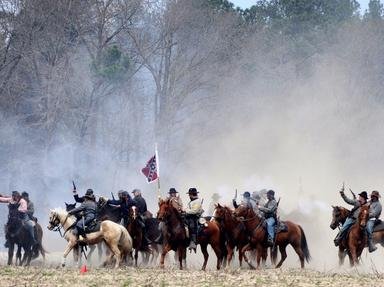Quiz Answer Key and Fun Facts
1. When did the Battle of Monocacy take place?
2. Who commanded the Confederate and Union forces at the Battle of Monocacy?
3. Even before the battle took place, the village of Monocacy Junction, Maryland, was the site of important Civil War events. Which of the following happened in the same area?
4. What did U. S. Grant say of the Union commander AFTER the Battle of Monocacy took place?
5. Which one of the following sites was NOT located on or near the Monocacy battlefield?
6. Confederate forces crossed the Potomac River, on their way to Monocacy and Washington, near which of the following towns?
7. From which of the following pairs of Maryland towns did the Confederate forces demand a ransom on the threat of burning them to the ground?
8. Not knowing the intended target of the invading Confederate force the Union commander settled on a defense at Monocacy Junction because ... ?
9. Hearing of the threat on Washington, Grant sent a division under this man to support the Union commander trying to intercept the rebel force (the first of the reinforcements to arrive back in Washington). Who was he?
10. This is an entirely accurate statement about the Battle of Monocacy ... "Although the Union forces were a highly trained, highly disciplined, and battle hardened army they could not stop the Confederate forces who outnumbered them almost 8 to 1."
11. Which of the following was NOT an objective of the 'invasion' that lead to the battle of Monocacy?
12. For the commanding Union general the Battle of Monocacy redeemed a reputation tarnished at ... ?
13. Confederate troops under this man found a ford across the Monocacy River and attacked the Union left flank, where they ran into the few veteran troops available to the Union, and were forced to fall back with heavy casualties until reinforcements arrived.
14. Which of the following was one of the few veteran combat units available to the Union commander?
15. After the battle of Monocacy, and after unsuccessful attacks by them on Fort Stevens defending the outskirts of Washington, the Confederates crossed back into Virginia. They were persued by Phil Sheridan's cavalry and soundly defeated at what battle?
16. Present at the Battle of Monocacy was a Confederate general who had won fame for his defense of the sunken road at Antietam. Who was he?
17. The Confederate march toward Washington that lead to the Battle of Monocacy also accomplished something that was not one of the move's original objectives. Which event below was the unintended accomplishment?
18. Which of the Union Major-Generals below was captured by Confederate forces two days after the Battle of Monocacy?
19. This civilian railroad executive played an important role in the events leading to the Battle of Monocacy. Who was he?
20. Confederate troops under General Robert Rhodes attacked the Union right flank forcing those troops to withdraw to the southern bank of the Monocacy River via ... ?
Source: Author
hohohaha
This quiz was reviewed by FunTrivia editor
bloomsby before going online.
Any errors found in FunTrivia content are routinely corrected through our feedback system.
